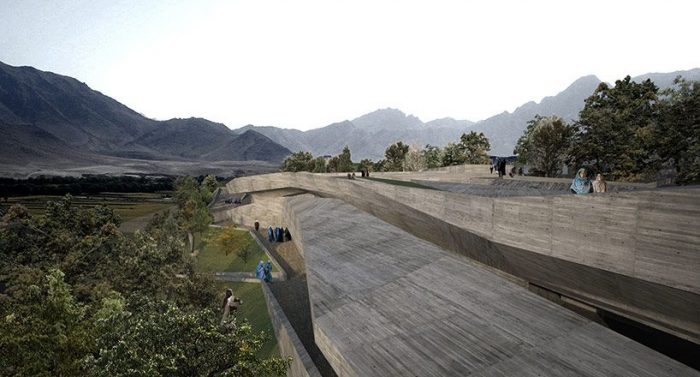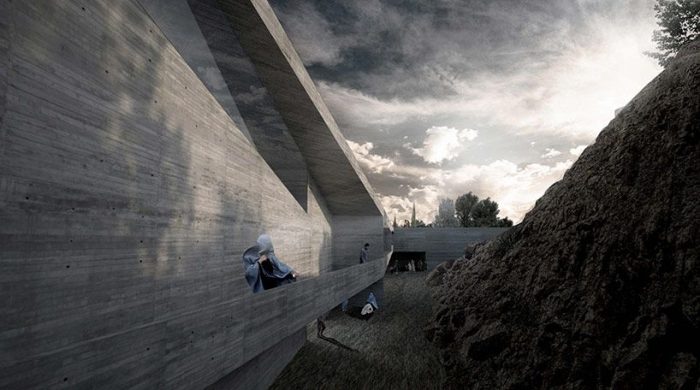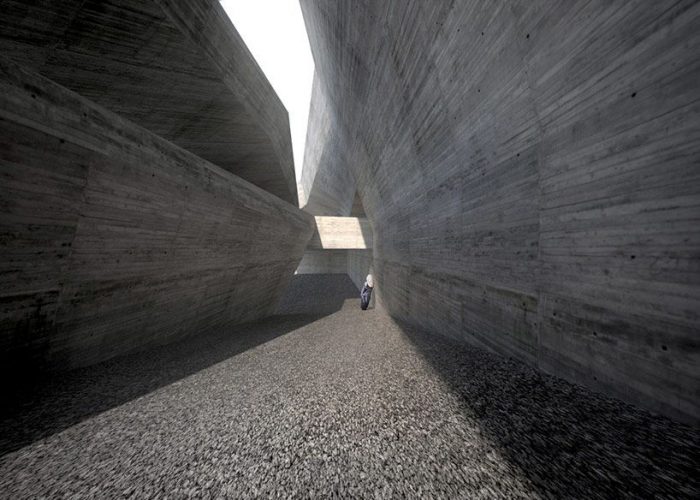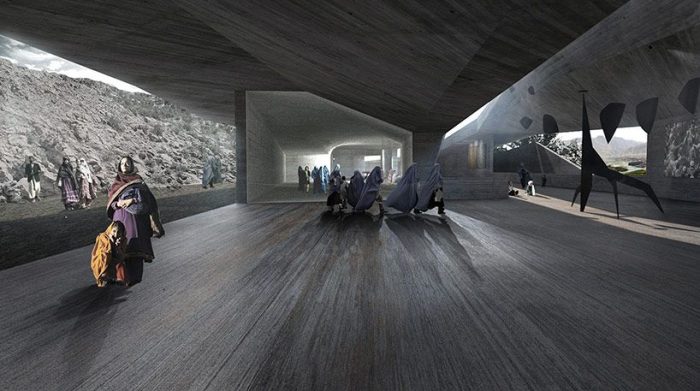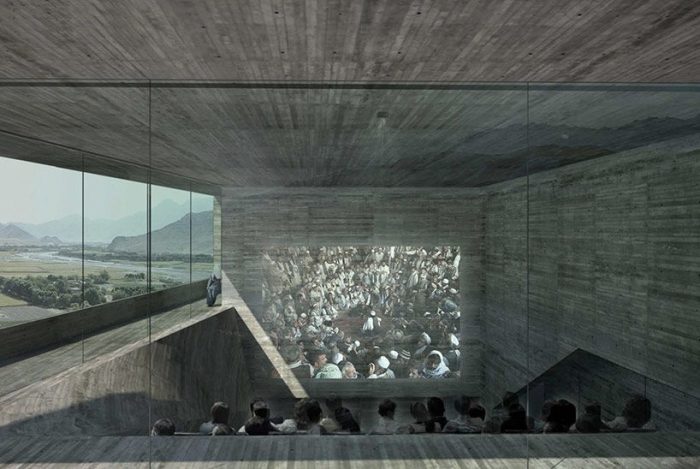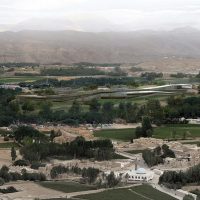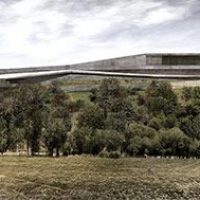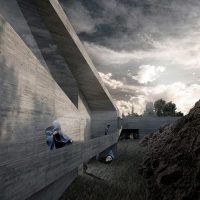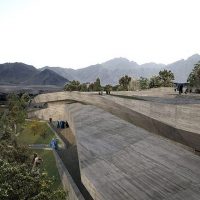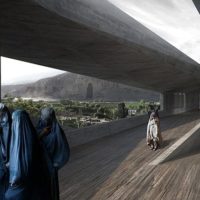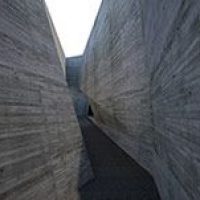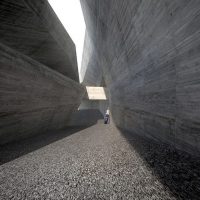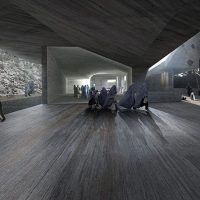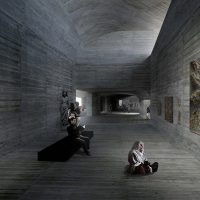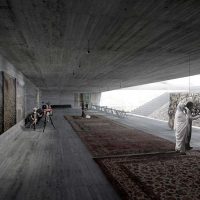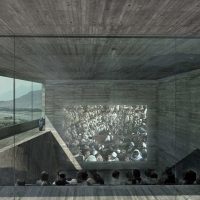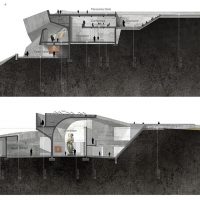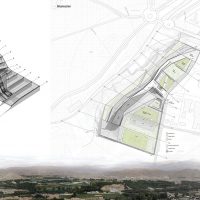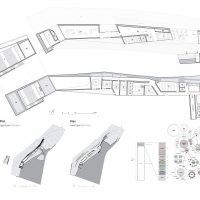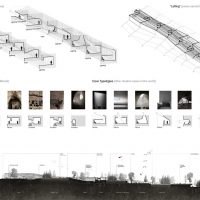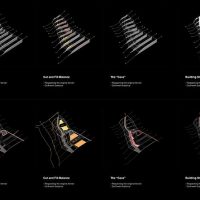Bamiyan Cultural Centre competition
In a way vaguely reminiscent of the soviet monuments that, in the latter part of that republic populated its borderlands, reMIX studio presents Con-Cave: Bamiyan Cultural Centre, in Afghanistan. Only this time, it’s 2015, and it’s the “marvelous” monuments of late capitalism and its free-form architectural possibilities that populate these lands (not for long) on the fringe of full-scale globalization.
Judging by its slithering through the hills and mounds, one could, at first glance, deem this project as just another attempt at architectural showmanship through sculptoric and plastic bravado. But upon further analysis, Con Cave reveals itself to be much more than that.
First, the rugged and mountainous character of this part of Afganistan makes its way into the building itself: sheer, massive, almost monolithic concrete is the main material used. The authors speak of a “(…) synthetic morphological and structural unity that emerges from the landscape”. We could, in fact, go even further, saying that reMIX have effectively and by definition remixed the landscape – they took an existing piece of content (the “mountain”) and gave it a new face, a new substance and a new interpretation.
We could speculate that the goal of reMIX is to strike a chord in the ancient and collective memory of Man – as if to remind us of what it is to look for and be sheltered amidst rocky formations and caves. This project is not a closed building, but a public infrastructure – accessible and permeable like any other mountain one sees around it. This type of free acess further suggests a character of free exploration, of strolling and wandering in the mountains.
In Con-Cave, Mohammed not only goes to the mountain, Mohammed creates the mountain. Only instead of using rock, he uses concrete. And he – or in this case, reMIX – makes it a continuation of the topography of these rugged lands. They carve and open it as if to let the sun shine through piled up rocks and cracks in boulders, in natural-esque corridors and galleries.
The spaces and tectonics of ConCave are, in fact, an exercise on the typological possibilities of the Cave, the Mountain and the Rock; but here, in the shape of tunnels, chambers and galleries made of sheer concrete. Each space is thus conceived as if it were a different type of cave, or tunnel, through the mountain. Ramps that lead into the tunnel and the terrace, which in turn leads to the chambers that hold the activities create an intertwined programmatic organization, that allows for different operational times.
Sometimes, museums are conceived as being the most passive possible receptacles for art; sometimes, they are so impositive with their own presence that there is no place for art. In this case, however, the argument for an alternative positioning in this dicotomy could be made. Con Cave makes place for art – typical of the Baiyman people and history – in a building that attempts to honour the setting in which said art was created. In other words, the building is like the surrounding mountains, that have throughout the centuries served as canvases for myriad Buddha sculptures and carvings. It’s multiple variations on the cave and its section and typology, as seen above, provide a spatial variety in which the space itself is not the protagonist, but a very important supporting actor. Each space is different, while still being a cave – and this is exactly what the whole building wants to be.
It could be said that, despite being an unquestionably contemporary exercise on architecture, reMIX have not proposed to do what so many others do – which is to say “fuck context” and propose a “monument” of globalization and capitalism, in contrast with its setting and its people.
Instead, Con-Cave is a creative exercise on typology, on the plasticity of sheer concrete and on the openness and accessibility of a building-made-topography. One could even go so far as to say that Con Cave attempts to elicit some sort of effect on the deep, intimate level of the relationship between Mankind and the burrow, the hole and the cave. These spaces that, for so many millennia were, our homes and our canvases; shelters for both Man and his Art.
Daniel Anthony Fraga.
- courtesy of remix studio
- courtesy of remix studio
- courtesy of remix studio
- courtesy of remix studio
- courtesy of remix studio
- courtesy of remix studio
- courtesy of remix studio
- courtesy of remix studio
- courtesy of remix studio
- courtesy of remix studio
- courtesy of remix studio
- courtesy of remix studio
- courtesy of remix studio
- courtesy of remix studio
- courtesy of remix studio
- courtesy of remix studio


